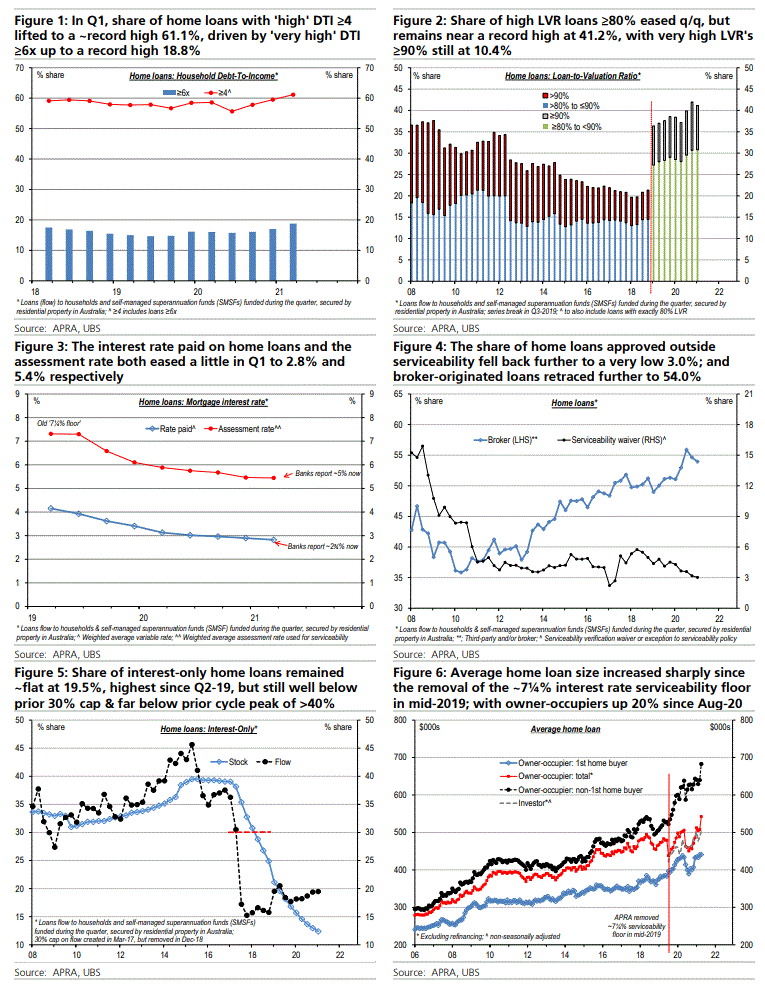UBS with the note:
April home loans up-crash 86% since May; average OO loan jumps 20% vs Aug
The housing market ‘up-crash’ is still accelerating. Home loan values in Apr-21 surged 3.7% m/m, to a record high, up 86% since May-20. Average loan size since Aug-20 jumped 20% for owner-occupiers to $542k; & investors +10% to $503k. This will likely continue with May dwelling prices +2.3% m/m & 10.6% y/y (and thce number of sales spiking ~92% y/y). We also still expect prices to reach ~15% y/y ahead. A key driver is investors returning to the market, with loans up almost 50% since Nov-20, and 91% since May; albeit after ~halving (from 2017) to the lowest level since 2002.
Q1 higher-risk loans share little changed, but DTI ≥6x up to record 18.8% share
But importantly, most categories of higher-risk home loans surprisingly showed little change q/q in Q1. The most significant deterioration was 1) the share of ‘high’ DebtTo-Income (DTI) ratio ≥4x lifted to a ~record high 61.1% (after 59.5%); entirely driven by ‘very high’ DTI ≥6x up to a record 18.8% (after 17.0%). 2) ‘High’ LVR loans ≥80% eased from to 41.2% (after a record high 42.0%), including ‘very high’ LVRs ≥90% back to 10.4% (after 11.3%). 3) Average interest rates ticked down for the interest rate paid (2.8% after 2.9%); & loan assessment (5.4% after 5.5%), further below the 7¼% ‘floor’ required by APRA until mid-2019. 4) Meanwhile, broker-originated loans eased back further (54.0% after 54.6%). 5) Interest-only loans were ~flat (19.5%, after 19.4%), at the highest since Q2-19, albeit still well below the prior 30% ‘cap’ which ended in 2018, and further below the prior cycle peak of >40% in 2015. 6) The share of loans outside serviceability ticked down to near a record low (3.0%, after 3.2%).
Pick-up in housing credit still likely trigger for macro-prudential tightening
The RBA’s June meeting added “there has been increased borrowing by investors”, but didn’t signal a near-term policy reaction, by repeating they “will be monitoring trends in housing borrowing carefully”. Recently Debelle also “recognise[d] rising house prices heighten concerns in part of the community…and there are a number of tools that can be used to address the issue but I don’t think that monetary policy is one”. Hence, we continue to argue the RBA is unlikely to raise the cash rate to specifically target housing. That said, our expectation of macro-prudential tightening is now more about unsustainable increases in prices and leveraging. However, the urgency based on a deterioration in lending standards alone isn’t there yet, and our base case of timing is now more likely in 2022 than Oct/Nov 2021. But we highlight previous APRA comments which implied the trigger is “signs that housing credit growth is picking up, and likely to outpace income growth for the foreseeable future”. Indeed, at that time, credit was only 3½% y/y, but in April increased to 4½%, and our flow model suggests a surge to >8% within a year (an upside risk to our forecast ~7%).
May business conditions super-boom to record; and inflation pressure lifts
The NAB business survey super-boomed to another record high in May, with conditions spiking to 37.2 (after 31.9) – or ~3½ standard deviations above the average since 1997. Business confidence eased, albeit from a ~record high (19.8, after 23.5), and the easing of Victoria’s lockdown should support confidence ahead. Importantly, there was a material further lift in inflation pressure. The wages bill picked up further to a cycle (record) high; and selling prices spiked to near a record high, suggesting Q2 CPI far above the RBA’s forecast, and upside to the inflation outlook if sustained.


